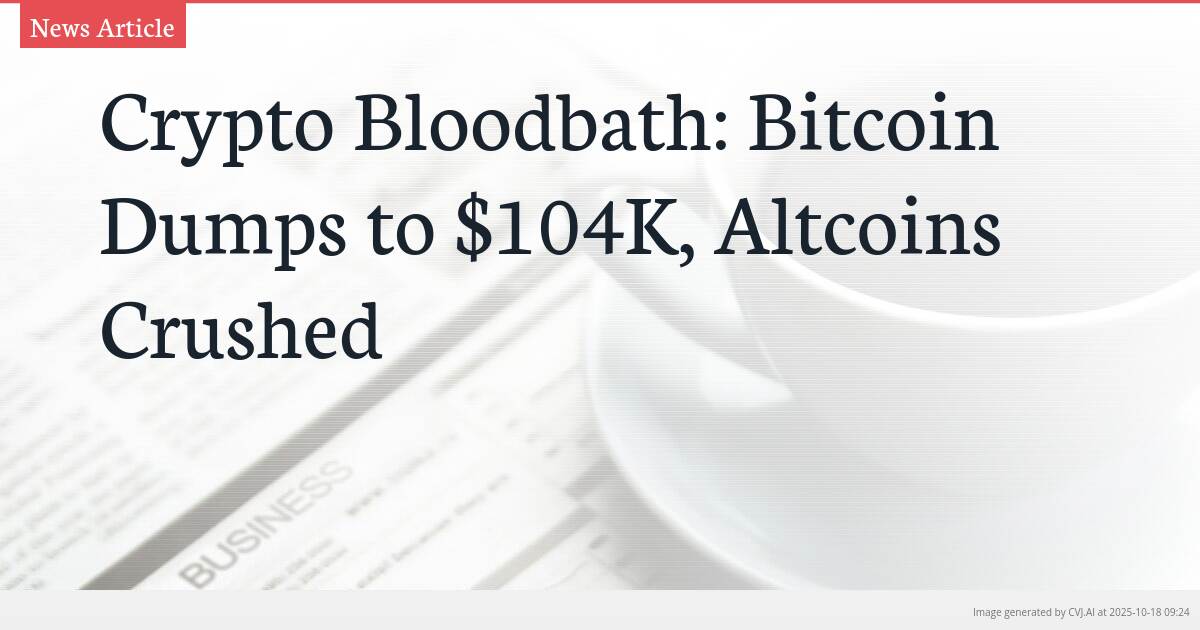This summary text is fully AI-generated and may therefore contain errors or be incomplete.
Introduction
Cryptocurrency markets experienced one of their most turbulent weeks in recent memory as Bitcoin plunged to multi-month lows below $104,000, triggering a widespread sell-off that wiped approximately $500 billion from the total market capitalization. The dramatic downturn, which began last Friday and intensified throughout the week, saw Bitcoin lose nearly 15% of its value while altcoins suffered even steeper declines, with Ethereum falling below $3,900 and Binance Coin losing critical support at $1,100. Despite a partial recovery sparked by positive macro news from US President Trump regarding China tariffs, market sentiment remains fragile as Bitcoin stabilizes around $107,000 while most alternative cryptocurrencies continue to struggle.
Key Points
- Bitcoin experienced a 15% decline from $122,000 to below $104,000, hitting three-month lows before recovering to $107,000
- Total cryptocurrency market capitalization dropped by approximately $500 billion during the week-long sell-off
- Market recovery was partially triggered by positive macro news regarding US-China trade relations, though altcoins continue to underperform Bitcoin
Bitcoin's Rollercoaster Week
The cryptocurrency market collapse began in earnest last Friday when Bitcoin plummeted from $122,000 to $110,000, with some exchanges like Binance seeing even steeper declines to $101,000. After a brief weekend recovery that maintained support above $110,000, the world’s largest cryptocurrency staged a modest rally at the start of the business week, peaking at $116,000 on both Monday and Tuesday. However, this recovery proved short-lived as Bitcoin faced immediate and painful rejection at this resistance level, sending prices tumbling back to $110,000.
The situation deteriorated further on Thursday evening when Bitcoin’s support at $110,000 finally gave way under sustained bearish pressure. The selling intensified on Friday, driving Bitcoin first to $108,000 and then below $104,000, marking a three-month low on most major exchanges. This substantial collapse saw Bitcoin’s market capitalization shrink to $2.130 trillion, though its dominance over alternative cryptocurrencies actually increased to 57.3% as altcoins suffered even more severe losses during the market-wide downturn.
The bleeding finally stopped when positive macro news emerged from US President Trump, who announced that the tariffs he had imposed on China the previous week would not stand. Bitcoin reacted immediately with a bounce to over $106,000 and has since added another thousand dollars to trade around $107,000. This partial recovery highlights the cryptocurrency market’s continued sensitivity to traditional financial and geopolitical developments, even as it establishes itself as an increasingly mature asset class.
Altcoin Carnage Worsens
While Bitcoin’s decline captured headlines, the alternative cryptocurrency market experienced even more devastating losses. Ethereum, the second-largest cryptocurrency by market capitalization, fell below the critical $3,900 level despite showing only minor declines on a 24-hour scale. Binance Coin suffered a 3% drop that pushed it below the $1,100 support level it had maintained through much of the recent bull market. The pain extended across virtually all major altcoins, with TRON, Dogecoin, Cardano, Chainlink, Hyperliquid, Bitcoin Cash, Sui, Avalanche, and Hedera all trading in negative territory.
Among the few bright spots in the altcoin space, XRP, Solana, and Stellar managed to post minor gains, though these were insufficient to offset the broader market decline. The most severe losses occurred in smaller-cap tokens, with COAI dumping another 17% in the past 24 hours alone, followed by AAVE declining 5.3% and ASTER dropping 5%. The contrasting performance of ENA, which surged by 12.5%, and TAO, which gained 8%, provided rare examples of resilience in an otherwise devastated altcoin landscape.
The total cryptocurrency market capitalization has recovered to just over $3.7 trillion according to CoinGecko data, but this represents a staggering $500 billion decline since the previous Friday. The disproportionate suffering among altcoins compared to Bitcoin’s relative stability underscores the flight to quality that typically occurs during market downturns, with investors preferring the relative safety of established cryptocurrencies over more speculative alternatives.
Market Outlook and Recovery Prospects
The cryptocurrency market’s dramatic week highlights the continued volatility that characterizes digital asset trading, even as institutional adoption increases and regulatory frameworks develop. The swift recovery following President Trump’s tariff announcement demonstrates how sensitive cryptocurrency prices remain to traditional financial market developments and geopolitical events. This interconnectedness suggests that cryptocurrency investors must now monitor not only blockchain-specific developments but also broader macroeconomic trends that can trigger rapid price movements.
Looking forward, market participants will be watching closely to see if Bitcoin can maintain its current stabilization around $107,000 or if further downside pressure emerges. The increased Bitcoin dominance at 57.3% indicates that capital is flowing out of riskier altcoins and into the relative safety of the market leader, a pattern that typically persists until clear bullish momentum returns. For altcoins to mount a sustainable recovery, they will likely need to demonstrate stronger fundamentals and clearer utility propositions to justify their risk profiles compared to Bitcoin.
The events of the past week serve as a stark reminder that despite cryptocurrency’s maturation as an asset class, dramatic price swings remain an inherent characteristic of these markets. Investors navigating this landscape must balance the potential for substantial returns against the reality of periodic severe corrections, with proper risk management becoming increasingly crucial as the total market capitalization approaches $4 trillion and attracts more mainstream participation.
📎 Read the original article on cryptopotato.com

